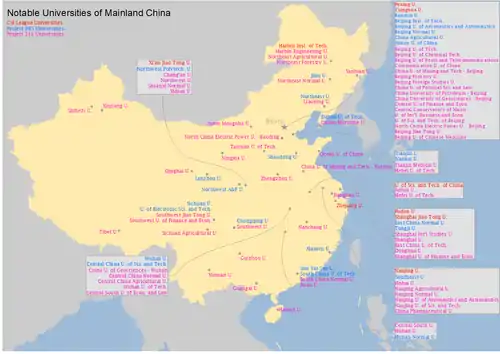Project 211
Project 211 (Chinese: 211工程; pinyin: èryāoyāo gōngchéng or èryīyī gōngchéng) was a project of National Key Universities and colleges initiated in 1995 by the Ministry of Education of the People's Republic of China, with the intent of raising the research standards of high-level universities and cultivating strategies for socio-economic development. During the first phase of the project, from 1996 to 2000, approximately US$2.2 billion was distributed.[1]

| History of the People's Republic of China (PRC) |
|---|
.svg.png.webp) |
| History of |
| Generations of leadership |
|
|
By 2008, China had 116 institutions of higher education (about 6 percent) designated as 211 Project institutions for having met certain scientific, technical, and human resources standards and offering advanced degree programs. Project 211 schools take on the responsibility of training four-fifths of doctoral students, two-thirds of graduate students, half of students from abroad and one-third of undergraduates. They offer 85% of the state's key subjects, hold 96% of the state's key laboratories, and consume 70% of scientific research funding.[2] According to the Academic Ranking of World Universities 2018/19 and the Times Higher Education World University Rankings 2019/20, most of these universities in the Project 211 are ranked among the top 1000 universities worldwide.[3][4]
The name for the project comes from an abbreviation of the slogan "面向21世纪,办好100所高校 (In preparation for the 21st century, successfully managing 100 universities)". One hundred was the approximate number of participating universities.[5]
Since 2014, Project 211 was less mentioned and gradually succeeded by a new project called plan 111 (Program of Introducing Talents of Discipline to Universities).[6][7]
In September 2017, a related plan called the Double First Class University Plan was announced.[8][9] It was unclear whether this plan represents a new way of ranking universities in China,[8] or replaces Project 211 and Project 985.[9]
List of universities
See also
References
- Li Lixu (2004). "China's Higher Education Reform 1998-2003: A Summary" (PDF). Asia Pacific Education Review. V (1): 14–22. Archived from the original (PDF) on June 23, 2010.
- Over 10 billion yuan to be invested in "211 Project" - People's Daily Online Archived 2008-04-28 at the Wayback Machine
- "World University Rankings". Times Higher Education (THE). August 20, 2019. Retrieved May 5, 2020.
- "ARWU World University Rankings 2019 | Academic Ranking of World Universities 2019 | Top 1000 universities | Shanghai Ranking - 2019". www.shanghairanking.com. Retrieved May 5, 2020.
- ""211工程"大事记". Ministry of Education, PRC (in Chinese). Archived from the original on November 22, 2016. Retrieved March 8, 2017.
- "Archived copy". Archived from the original on September 9, 2017. Retrieved September 9, 2017.CS1 maint: archived copy as title (link) 南京有高校称“211建设”已暂停
- "Archived copy". Archived from the original on September 9, 2017. Retrieved September 9, 2017.CS1 maint: archived copy as title (link) 985、211取消后 仅88所高校入选“111计划”(名单)
- "China to develop 42 world-class universities". People's Daily. September 21, 2017.
- "双一流大学 (shuāngyīliú dàxué): Double top university plan". Archived from the original on September 25, 2017.